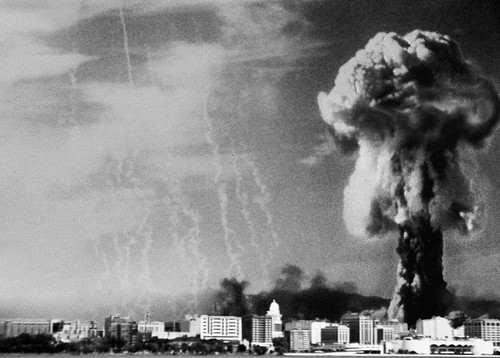
MADRID – Since its launch in December 2008, Global Zero, the vision of a world without nuclear weapons, has run up against some formidable challenges. One is related to the readiness of the two major nuclear powers, Russia and the United States, to move from the stockpile reductions to which they agreed in the New START treaty to complete elimination of their nuclear arsenals. Others concern smaller nuclear powers’ willingness to go along, and whether reliable inspection, verification, and enforcement systems can be put in place.
But these issues are not the real problem. Although Russia and the US possess roughly 90% of the world’s nuclear warheads, their nuclear capabilities are less of a threat than is the danger of proliferation. It is this fear of a fast-growing number of nuclear-armed states, not the fine balancing of the US and Russian nuclear arsenals, that the case for Global Zero must address. Indeed, addressing the underlying security concerns that fuel nuclear competition in regional trouble spots is more important to the credibility of Global Zero’s goal of “a world without nuclear weapons” than is encouraging exemplary behavior by the two major nuclear powers.
After all, North Korea, India, Pakistan, Iran, and Israel might not be particularly impressed by a reduction in the US and Russian nuclear-weapons stockpiles from gross overkill to merely mild overkill. There is a stark lack of synchrony between the (admittedly qualified) improvement in the two major nuclear powers’ bilateral relations and conditions in volatile regions around the world.
This gap is bound to affect negatively the processes of nuclear disarmament that are now being envisaged, for these states’ flirtation with nuclear weapons is not just a quest for prestige or status; it is an attempt to counter the conventional superiority of hostile neighbors – or, as with Iran and North Korea, of the US itself.
Consider Pakistan, for which repeated defeat at the hands of its sworn enemy, India, in conventional wars has been the catalyst for its readiness “to eat grass,” as Zulfikar Ali Bhutto famously put it, in order to counter India’s conventional superiority and nuclear capabilities. Today, Pakistan possesses more nuclear warheads than India does. To get to zero in this region, the conflict over Kashmir must be resolved, and India must cease being perceived by Pakistan as a threat.
Ironically, the Russian case is no different from that of Pakistan, Iran, or North Korea. Notwithstanding the undeniable progress so far in Russia-US nuclear talks, the task of minimization, let alone elimination, of nuclear weapons by the Russians will depend on a willingness to address the Kremlin’s key security concern: its conventional military inferiority vis-à-vis the West.
Meanwhile, Israel’s genuine, if arguably exaggerated, existential anxiety helps to explain its strategy of nuclear opacity. The prevailing perception in Israel is that of being surrounded by formidable non-nuclear threats, and dangerously weakened by the poor capacity of the state’s domestic front to sustain a long conventional war. A country that in the summer of 2006 had to send a million of its citizens to underground shelters to escape massive ballistic warfare conducted by a non-state agent, Hezbollah, now faces an “Islamic Awakening” that it cannot fully fathom, and, with it, an ominous worsening of its strategic environment.
Nor can Israel ignore the Middle East’s infamy as the only region in the world where chemical and biological weapons have been used since World War II. Iraq used them against Iran in the 1980’s, Egypt in Yemen in the 1960’s, and Iraq against its own Kurds.
But the cause of nuclear disarmament could advance in December, when the conference for the establishment of a “Middle East Free of Nuclear Weapons and all other Weapons of mass Destruction” will be held in Helsinki (with, one hopes, all states in the region, including Israel and Iran, in attendance). But the initiative must avoid unworkable shortcuts. For example, the Arab position, which addresses Israel’s nuclear status outside the region’s broader security context, is the best recipe for failure.
Instead, the conference needs to begin a dialogue among all stakeholders about their underlying security concerns. The lesson for the Middle East in the mutual reduction of nuclear stockpiles by the US and Russia is that genuine disarmament is impossible unless preceded by an improvement in inter-state relations. This is also the lesson of the other five world regions – Latin America, the South Pacific, Southeast Asia, Central Asia, and Africa – that have adopted treaties establishing zones free of nuclear weapons.
Israel needs to understand that its nuclear strategy cannot be sustained forever, and that Iran’s challenge to its supposed nuclear monopoly is not an obsession exclusive to the Iranian leadership. A Middle East free of nuclear weapons certainly is preferable to a region with two or more nuclear-weapons states. But the Arab countries should assume that, unless and until they normalize their relations with Israel, effective engagement with it on such vital issues will remain impossible. Peace and regional de-nuclearization must go hand in hand.
Israel’s then-prime minister, Shimon Peres, was not exactly opaque when he declared in December 1995 that, if given peace, Israel “would give up the atom.” But the current incumbent, Binyamin Netanyahu, cannot have it both ways, conditioning nuclear disarmament on peace while doing everything he can to stall the peace process.
Copyright Project Syndicate
Shlomo Ben Ami, a former Israeli foreign minister who now serves as the vice president of the Toledo International Center for Peace, is the author of Scars of War, Wounds of Peace: The Israeli-Arab Tragedy.
For additional reading on this topic please see:
Israel: Possible Military Strike Against Iran’s Nuclear Facilities
The North Korean Nuclear Issue: Between Containment and Dialogue
For more information on issues and events that shape our world please visit the ISN’s featured editorial content and Security Watch.

